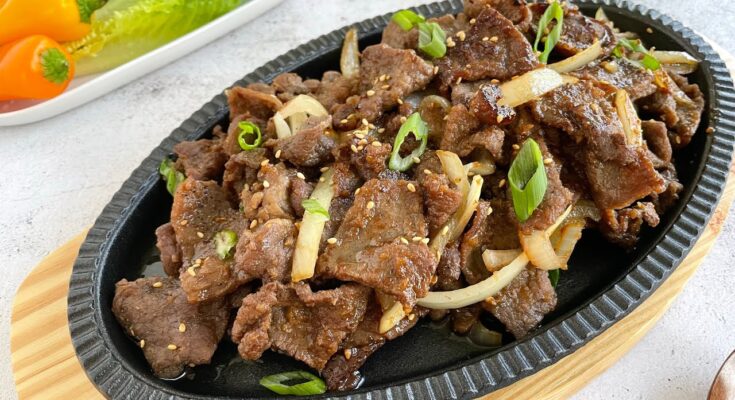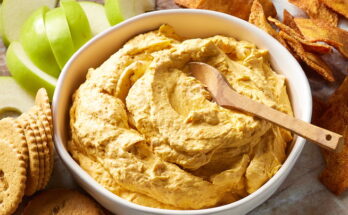Korean Bulgogi Recipe: Korean cuisine is famous for its bold flavors and delicious balance of sweet, salty, and savory, and Bulgogi is no exception. This grilled Korean BBQ beef dish has won hearts across the globe.
Whether you’re new to Korean cooking or a seasoned home chef, this step-by-step guide will walk you through making the most flavorful, juicy Bulgogi right in your kitchen.
What is Bulgogi?
Bulgogi, which literally translates to “fire meat” in Korean, is a marinated beef dish traditionally grilled over an open flame. The meat is thinly sliced, marinated in a mixture of soy sauce, sugar, sesame oil, garlic, and pepper, then grilled, pan-fried, or cooked on a hot plate. The result is a tender, juicy meat full of flavor with slightly caramelized edges.
It’s often served with rice, lettuce leaves (for wrapping), and various side dishes like kimchi, making it a well-rounded meal. It’s not just a dish; it’s an experience—shared, savored, and remembered.
History and Cultural Significance of Bulgogi
Bulgogi dates back to the Goguryeo era (37 BC to 668 AD), when it was known as “maekjeok.” Over centuries, the cooking methods evolved—from skewering and grilling over fire to pan-frying in modern kitchens. Bulgogi represents the Korean love for harmony in food—sweet and savory, tender and crispy, simple yet deeply flavorful.
In modern Korea, it’s a beloved home-cooked meal and also a festive food served during holidays and family gatherings. Its universal appeal has made it one of Korea’s most popular culinary exports.
Ingredients You’ll Need
Essential Ingredients
To make authentic Bulgogi, you don’t need a fancy pantry, but you do need the right ingredients. Here’s a list of essentials to get started:
- Beef (Ribeye or Sirloin) – Thinly sliced, marbled cuts for tenderness
- Soy Sauce – The salty base of your marinade
- Brown Sugar or Honey – Adds sweetness and caramelization
- Garlic (minced) – For that essential Korean zing
- Sesame Oil – Brings nuttiness and depth
- Ground Black Pepper – Adds a mild heat
- Onion (sliced) – Provides moisture and natural sweetness
- Green Onions – Adds a fresh finish
- Asian Pear (optional but traditional) – Tenderizes the meat naturally and adds fruity notes
These ingredients create the base of your Bulgogi. Together, they strike the perfect balance of flavor and texture.
Optional Add-Ons and Substitutes
Not everyone has access to Asian markets, but don’t worry—there are easy workarounds.
- Substitute for Asian Pear: Use a regular pear or apple with a dash of sugar.
- Soy Sauce Alternative: Tamari or coconut aminos for a gluten-free version.
- Extra Flavor Boosters: Add gochujang (Korean chili paste) if you want some spice, or a splash of rice wine vinegar for tang.
- Vegetable Add-ins: Bell peppers, mushrooms, and carrots add color and nutrients.
These flexible options ensure you can still make a delicious dish even if you’re missing a few traditional items.
Preparing the Meat
Choosing the Right Cut
The soul of Bulgogi lies in its beef. For best results, choose well-marbled cuts like:
- Ribeye – Rich and juicy with perfect fat distribution
- Sirloin – Leaner but still flavorful
- Brisket or Flank Steak – For a slightly chewier texture
Avoid tough cuts, as they don’t do well with quick cooking. The goal is meat that cooks fast and stays tender. When in doubt, ask your butcher to recommend a thin, marbled cut suitable for grilling or stir-frying.
How to Slice the Meat Thinly
Thin slicing is crucial for that melt-in-your-mouth feel. Here’s how to get it right:
- Freeze the Beef Slightly: Put your beef in the freezer for about 30 minutes. This firms it up and makes slicing much easier.
- Use a Sharp Knife: A dull knife will shred the meat. Go for a long, thin-bladed knife and slice against the grain.
- Aim for 1/8 inch thick: Thin enough to cook quickly but not so thin that it falls apart.
You can also buy pre-sliced Bulgogi meat from Asian groceries if you’re in a hurry, but cutting it yourself ensures maximum freshness.
Making the Bulgogi Marinade
Classic Bulgogi Marinade Components
This marinade is where all the magic happens. It’s a symphony of salty, sweet, and savory. Here’s a basic breakdown:
- 1/2 cup soy sauce
- 2 tbsp brown sugar (or honey)
- 2 tbsp sesame oil
- 4 cloves garlic (minced)
- 1/2 Asian pear (grated)
- 1/2 onion (grated or finely chopped)
- 1/4 tsp ground black pepper
- 2 tbsp rice wine (optional but adds depth)
Mix all these together in a bowl until the sugar dissolves and everything blends into a fragrant, sticky sauce.
Tips for a Flavor-Packed Marinade
Want next-level Bulgogi? Follow these marinade secrets:
- Use freshly grated ingredients – Grated pear and onion seep deeper into the meat.
- Let it sit – Give the marinade at least 10 minutes to rest before adding meat. This lets the flavors blend.
- Massage the meat – Mix the meat and marinade with your hands. It helps the flavors penetrate better.
- Balance is key – Taste before adding meat. Too salty? Add more pear or sugar. Too sweet? A dash more soy sauce.
These small steps go a long way in ensuring every bite of your Bulgogi bursts with authentic Korean flavor.
Marinating the Meat
How Long to Marinate Bulgogi
Marinating is the heart of making Bulgogi that’s tender and bursting with flavor. While you might be tempted to rush this step, patience really pays off.
Ideally, you should marinate the beef for at least 4 hours, but overnight is even better. If you’re in a hurry, a quick 30-minute soak can still produce decent results, but the longer you let the beef sit in the marinade, the more flavorful and tender it will become. The natural enzymes in the Asian pear (or apple, if you’re using that as a substitute) break down tough fibers in the meat, making it melt-in-your-mouth delicious.
Make sure to store the marinated meat in an airtight container or zip-top bag. This ensures all the beef is evenly coated and helps lock in the flavors. If you’re using a bowl, give the beef a quick toss every couple of hours to redistribute the marinade.
One trick pros use is marinating in layers—laying slices of meat flat with marinade in between instead of dumping it all together. This technique makes sure every bit of meat gets an equal share of that sweet-savory goodness.
Storing Marinated Meat Properly
Proper storage is just as important as marinating itself. Here’s what you need to keep in mind:
- In the Fridge: Store marinated Bulgogi in the refrigerator for up to 24 hours. Beyond that, the meat may become mushy, especially if you’ve used a fruit-based tenderizer.
- In the Freezer: If you’ve made a big batch, divide it into smaller portions and freeze in zip-top bags. Flatten each bag for easy thawing later.
- Label It: Don’t forget to write the date and contents on each bag or container. You’ll thank yourself later when you’re digging through your freezer.
Marinated Bulgogi freezes beautifully and is a lifesaver for quick dinners. Just thaw overnight in the fridge and it’s ready to hit the pan.
Cooking Bulgogi to Perfection
Stovetop Bulgogi
This is the most accessible and convenient way to cook Bulgogi at home. All you need is a large pan or skillet.
- Preheat the Pan: Use medium-high heat and add a touch of oil to prevent sticking.
- Cook in Batches: Don’t overcrowd the pan. Sear the beef in batches for that nice caramelized edge.
- Flip Sparingly: Let the meat brown on one side before flipping. You want that golden crust.
- Add Veggies (Optional): Toss in sliced onions, carrots, or mushrooms during the last couple of minutes.
This method is perfect for small kitchens and gives you great control over the cooking process.
Grilling Bulgogi
Want that smoky, authentic Korean BBQ flavor? Fire up the grill!
- Use a grill pan or basket: Since Bulgogi is thinly sliced, it can fall through the grates. A pan or foil-lined basket helps retain juices.
- Preheat Well: Make sure your grill is hot before you start. This sears the meat quickly, locking in moisture.
- Quick Cook Time: Each side needs just 1–2 minutes. Don’t overcook or it’ll turn dry.
- Baste for Flavor: Brush on some extra marinade as it grills for extra flavor and juiciness.
Grilling takes Bulgogi to a whole new level with a hint of char and that irresistible BBQ aroma.
Serving Suggestions for Bulgogi
Traditional Korean Style
In Korea, Bulgogi is more than a dish—it’s a full spread. Here’s how it’s traditionally served:
- With Steamed Rice: Plain white rice balances the rich flavors of the meat.
- Wrapped in Lettuce Leaves: Add a slice of garlic, a bit of rice, and gochujang (Korean chili paste) for a perfect bite.
- Banchan (Side Dishes): Serve with kimchi, pickled radishes, bean sprouts, and seasoned spinach.
These sides complement the savory sweetness of Bulgogi and turn it into a full Korean BBQ experience.
Modern Twists and Fusion Ideas
Get creative with how you serve your Bulgogi:
- Bulgogi Tacos: Use tortillas, add shredded cabbage, a spicy mayo, and a squeeze of lime.
- Bulgogi Rice Bowls: Top steamed rice with Bulgogi, sautéed veggies, and a fried egg.
- Bulgogi Sliders: Mini burgers with Bulgogi, pickles, and a spicy aioli.
These fusion ideas make Bulgogi versatile and fun, perfect for parties or a weeknight dinner upgrade.
Pairing Bulgogi with Drinks and Sides
Best Side Dishes for Bulgogi
To truly enjoy Bulgogi like a local, the side dishes—called banchan—are just as important as the main dish. These small, flavorful accompaniments enhance the taste of Bulgogi and create a balanced meal. Here are some classic and popular banchan options:
- Kimchi: Fermented napa cabbage or radish, spicy and tangy—this is a must-have on any Korean table.
- Namul (Seasoned Veggies): Try spinach, bean sprouts, or zucchini sautéed with sesame oil and garlic.
- Pickled Radish or Cucumbers: Sweet, sour, and crunchy—perfect to cleanse the palate.
- Japchae: Korean glass noodles stir-fried with vegetables and a light soy-based sauce.
- Potato Salad or Rolled Omelet (Gyeran Mari): Mild and comforting, balancing out the bold Bulgogi flavors.
These sides offer variety in texture and taste, turning your dinner into a Korean banquet.
Drinks that Complement Bulgogi
Korean cuisine pairs beautifully with a range of beverages, both traditional and modern. Here’s what works best with Bulgogi:
- Soju: Korea’s favorite spirit. Its clean, slightly sweet flavor balances the savory-sweet profile of Bulgogi.
- Makgeolli: A milky, slightly fizzy rice wine with a tangy kick—great for a BBQ spread.
- Beer: Light lagers work well to cleanse the palate between bites.
- Non-Alcoholic Options: Barley tea or Korean plum tea (maesil-cha) offer gentle, refreshing flavor without overpowering the dish.
Pairing Bulgogi with the right drink elevates your meal from simple dinner to a full-on cultural dining experience.
Common Mistakes to Avoid When Making Bulgogi
Over-marinating the Beef
One of the most common mistakes people make is letting the meat marinate too long—especially with a fruit-based marinade. While it may seem like longer is better, the enzymes in fruits like pear or kiwi can break down the meat too much, making it mushy rather than tender.
Pro tip: Stick to 4 to 12 hours. Overnight is perfect, but more than 24 hours is overkill.
Cooking All the Meat at Once
It might be tempting to dump all your marinated meat into the pan, but that’s a recipe for steaming, not searing. Overcrowding the pan traps moisture, and you’ll miss out on that delicious caramelization.
Solution: Cook in small batches. It may take longer, but each piece will be perfectly browned.
Skipping the Resting Time
Just like steak, Bulgogi benefits from a short rest after cooking. This allows the juices to redistribute, so every bite is juicy and flavorful.
Let the meat sit for about 5 minutes after cooking. It makes a noticeable difference.
Storing and Reheating Bulgogi
How to Store Leftover Bulgogi
Got leftovers? Lucky you! Bulgogi tastes even better the next day. Here’s how to store it properly:
- In the Fridge: Place in an airtight container and store for up to 4 days.
- In the Freezer: You can freeze cooked Bulgogi for up to 2 months. Wrap it well to avoid freezer burn.
Be sure to label your container with the date so you don’t forget when it was made.
Reheating Without Losing Flavor
Reheating Bulgogi is simple, but you want to keep the meat tender and juicy.
- Stovetop: Reheat in a skillet over medium heat with a splash of water or extra marinade to keep it moist.
- Microwave: Place in a microwave-safe dish with a damp paper towel on top. Heat in 30-second intervals until hot.
- Oven: For larger batches, reheat at 300°F (150°C) covered with foil for 10–15 minutes.
Avoid high heat, which can make the meat dry and tough.
Health Benefits of Bulgogi
Nutritional Value of Ingredients
Bulgogi isn’t just delicious—it’s also fairly nutritious, especially if you balance it with veggies and whole grains. Here’s what makes it a healthy choice:
- Beef: A rich source of protein, iron, zinc, and B-vitamins.
- Garlic & Onion: Boost immunity and improve heart health.
- Asian Pear & Veggies: Add fiber, vitamins, and natural antioxidants.
- Sesame Oil: Healthy fats that support brain and heart function.
By choosing lean cuts of meat and going easy on the sugar, Bulgogi can easily fit into a balanced diet.
How to Make It Healthier
Want to lighten up your Bulgogi without sacrificing flavor?
- Use leaner cuts like sirloin or even chicken breast.
- Reduce sugar or swap it for natural sweeteners like honey or stevia.
- Add more vegetables to bulk up the meal with fiber and nutrients.
- Serve in lettuce wraps instead of rice for a low-carb option.
With a few tweaks, Bulgogi becomes a guilt-free indulgence.
Bulgogi Variations Around the World
Regional Variations in Korea
While the basic concept of Bulgogi remains consistent, different regions in Korea have their own unique spin on it. Here are a few regional adaptations worth trying:
- Seoul-Style Bulgogi: The most commonly known version, made with a soy sauce-based marinade and grilled or pan-fried.
- Jeju Bulgogi: Known for using pork instead of beef, often with spicy marinades featuring gochujang.
- Andong Bulgogi: This version includes glass noodles and is cooked more like a stew, often with extra vegetables and broth.
- Gwangyang Bulgogi: This uses very thin beef cuts grilled over charcoal, giving it a smoky, BBQ-like flavor.
These variations reflect the diversity of Korean culinary traditions, each influenced by local ingredients and preferences.
International Fusion Bulgogi Dishes
The global popularity of Bulgogi has inspired countless fusion dishes that marry Korean flavors with international techniques:
- Bulgogi Pizza: Topped with marinated beef, mozzarella, onions, and sometimes even kimchi.
- Bulgogi Tacos: A hit in Korean-Mexican fusion cuisine, combining Bulgogi with spicy slaw and tortillas.
- Bulgogi Burgers: Juicy patties flavored with Bulgogi marinade, topped with kimchi slaw on brioche buns.
- Bulgogi Sushi Rolls: Incorporating grilled Bulgogi into maki rolls with vegetables and rice.
These creative dishes showcase Bulgogi’s incredible versatility and its ability to cross culinary borders.
Why You’ll Love Making Bulgogi at Home
Quick and Easy Weeknight Meal
Despite its restaurant-quality taste, Bulgogi is surprisingly easy to prepare at home. Most of the work is in the prep—once your beef is marinated, it cooks in just 5–10 minutes. That makes it perfect for:
- Busy weeknights
- Meal prepping
- Impressing guests with minimal effort
Plus, with so many customizable options, you can tailor it to your tastes or dietary needs.
A Crowd-Pleaser for All Ages
Bulgogi’s sweet-savory profile makes it incredibly family-friendly. Even picky eaters tend to love it, and it’s easy to serve in multiple formats—over rice, in wraps, or as a taco. Hosting a dinner party? Bulgogi works great in a DIY Korean BBQ setup where guests build their own wraps.
With a little prep and the right ingredients, Bulgogi becomes not just a meal but an event—interactive, flavorful, and fun.
FAQs about Korean Bulgogi Recipe
1. Can I make Bulgogi with chicken or pork instead of beef?
Absolutely! Chicken and pork are great substitutes. Just adjust the cooking time—chicken should be cooked through completely, while pork pairs wonderfully with a spicier marinade.
2. Is Bulgogi spicy?
Traditional Bulgogi is not spicy, but you can easily add heat with gochujang or red pepper flakes if you like it hot.
3. Can I prepare Bulgogi ahead of time?
Yes! Marinate the beef the night before, or even freeze portions for future use. It’s a great make-ahead meal.
4. What can I use instead of Asian pear in the marinade?
You can substitute with a regular pear, apple, or even a bit of pineapple juice to tenderize the meat and add sweetness.
5. Do I need special equipment to cook Bulgogi?
Not at all. A skillet, frying pan, or even a grill will work. For the most authentic taste, a cast-iron grill pan gives you those perfect sear marks and caramelization.
Conclusion
Bulgogi isn’t just a dish—it’s a celebration of Korean flavor, history, and culinary art. With its sweet, savory marinade and tender, juicy beef, it’s no wonder this iconic Korean BBQ staple has captured hearts (and stomachs) worldwide. Whether you’re trying it for the first time or adding it to your weekly dinner rotation, making Bulgogi at home is a rewarding experience that delivers big on taste with surprisingly little effort.
From slicing the beef just right to building the perfect marinade, every step adds up to a dish that’s bursting with flavor and tradition. So, roll up your sleeves, fire up that skillet or grill, and dive into the delicious world of Bulgogi—you won’t regret it.



